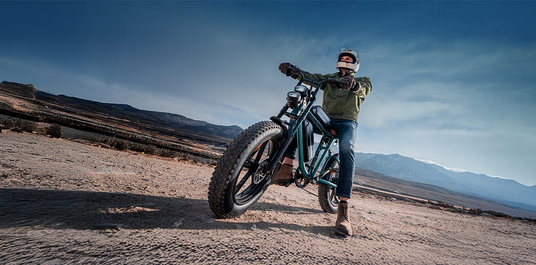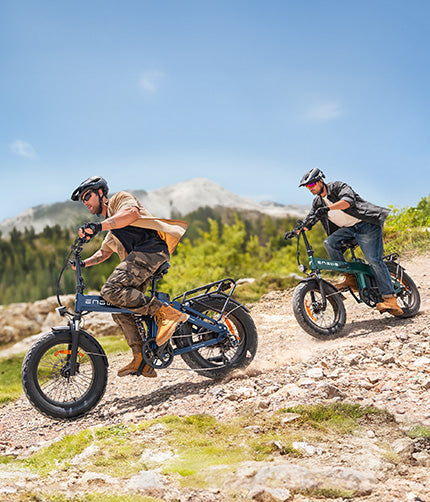The question I personally receive the most from the electric bike industry is: How long do e-bike batteries last per charge? It is the question that divides the browser from the buyer. You read some big number on a website and think it sounds like a huge number; think it must mean endless kilometres of easy riding. But let me assure you — as a seasoned cyclist — the number on the box is the laboratory best, the perfect-world scenario. Your actual mileage, the one that counts on your morning commute or weekend spin around town, is a dynamic number influenced by you, your surroundings and your electric bike. That’s what this guide is for, to help demystify that number, to go beyond the marketing and actually get a sense of what you can expect out of a single charge, and how to get the most out of it.
The 'It Depends' Answer Explained
When you get asked about range, the only honest first answer to provide is 'it depends'. This is not a ploy to avoid the question; it is the beginning of a more useful conversation. The manufacturer’s claimed range is generally estimated under optimal conditions: a light rider on a perfectly flat surface with no wind, in the lowest level of pedal assist (usually called PAS 1 or Eco mode). There's a good chance the day-to-day of your life is very different. Let’s parse out the main factors that will determine how many km you get.
First off is the entirety of the weight that your bike has to carry. So that's you, your backpack, groceries, child seats, etc. A rider who is 100 kg is going to deplete the battery much quicker than a rider who is 70 kg, because the motor will need to put in extra work to move the added weight of the rider. The next is terrain. Biking on a flat, paved bike path in the Netherlands feels like a different world than pedaling up the rolling hills of Tuscany or down the steep lanes of Lisbon. Every hill means a massive spike in power demand from the motor, which significantly impacts the amount of space you get to travel on a charge. Even small, steady ascents encountered day after day during a commute can accumulate.
Secondly, think about how you ride and how the pedal assist is being used. If the highest “Turbo” or “Boost” mode is used all the time you are, in effect, doing the opposite of what’s been suggested, and are asking the motor to do most of the work. This is great for a sudden blast of speed or getting over a really tough hill, though it will use up your battery in no time. Conversely, if you remain in a low assistance mode and add more of your own pedaling, you can increase your range greatly. The surface on which you ride, too, is a crucial factor. Smooth asphalt offers little resistance. Hitting up gravel, forest trails or sandy pathways causes much more rolling resistance, and forces the motor and battery to work harder to maintain speed. Mother nature speaks at last. A strong headwind is like climbing a hill the whole time; it can cut your range by 20% to 30% or more. Cold also directly degrades battery performance because chemical reactions occur more slowly inside a lithium-ion battery, temporarily decreasing the battery’s capacity and power output.
Into The Numbers: A Range Factor Table
To be very clear about this, let us compile these contributions into a table. Consider this your cheat sheet for deciphering and extending your electric bike’s range.
| Factor | Effect on Range | Explanation and How to Extend |
|---|---|---|
| Pedal Assist Level | Super High | The more assist you use (Turbo/Boost) drains the battery quicker. Think of it as flooring the gas pedal in a car. To maximize range, ride in the lowest assist level you’re comfortable with for the terrain and save the high-power modes for when you really need them, such as steep hills. |
| Rider & Cargo Weight | High | The heavier the load the motor has to move, the more energy it needs to consume. You can't reverse any of your own inflated tonnage, but you can make the most of what you carry by not lugging dead weight around. |
| Terrain & Hills | High | Hills and mountains are the enemy of an e-bike's range. To maximize, try to keep the momentum up going into a hill and shift well before it, just as you would on a “regular” bicycle. It’s motor-assist that does not overload the motor. |
| Weather (Wind & Temp) | Moderate to Strong | A strong headwind is a significant range killer. Lowering operating temperature (under 5°C) can temporarily decrease battery capacity. To maximize, you might charge and store your battery inside the house over the winter. When riding into the wind, getting lower as a way to be more aerodynamic can pay off a little. |
| Tire Pressure & Type | Medium | Low tire pressure increases rolling resistance, which saps energy away. Fat, knobby tires offer more grip but also more resistance than smooth, narrow road tires. To get the best fuel economy, however, it’s important to maintain the proper tire pressure, according to the manufacturer. It’s the simplest and most effective maintenance step that you can take to maximize your range. |
| Riding Style | Medium | Energy goes into frequent starting and stopping, rather than being saved by maintaining a constant speed. The battery drains with aggressive, quick acceleration. To maximize this, ride as smoothly as possible, anticipate when you need to stop and try to coast rather than hard brake, and gently accelerate. |
| Bike Maintenance | Low to Moderate | If you have a poorly maintained drivetrain (a rusty chain, an unlubricated one), you’re going to add friction to your bike and waste energy. Dragging brakes, too, create drag by rubbing against the wheel. To maximize, you need your chain clean and oiled, and brakes in proper adjustment. |

A Real-World Solution: The ENGWE EP-2 Boost
You can understand all this, but designing and then finding an electric bike that does work in reality is totally different. That’s where a well-designed bike such as the ENGWE EP-2 Boost really shines. It is made not for the perfect amount but for the wide-ranging needs of European riders. The star of the show is its large 48V 13Ah high capacity removable battery, which is responsible for the raw power output to enable a class-leading max range of up to 120 km in PAS 1 mode. But ENGWE takes it further by adding a high-level Torque Sensor. Unlike simpler systems, a torque sensor gauges how hard you are pedaling and feeds in a proportionate amount of power. The result is an incredibly natural-feeling assist that's eerily smooth and intuitive for the way it quickly responds to the effort you put out while pedaling, and more importantly, it's much more efficient, so it saves battery power and delivers more distance by giving you only the assist you actually need. For those "get me home" commutes where an extra push is needed up a steep bridge or sudden hill, the one-of-a-kind Boost button delivers a full 55Nm of torque for a ride that is safe, fast and exhilarating. That combination of a big battery, adaptive power delivery and immediate power make the EP-2 Boost an amazing performer. And it's got amazing flexibility with its 20x4.0 fat tires and one-piece wheels that combine comfort and stability on just about any terrain, from pavement to gravel to broken-up streets, plus the ability to fold in no time to take your ride wherever your travels may take you.

Your Action Plan: How to Get the Most From Every Charge
Now that you know the "why," here’s the "how." With some smart habits and techniques, you can add charger-free distance to every single charge. First up, getting to love your gears. Some new e-bike riders ride as if they forgot they have them. Down-shifting on uphill sections of the road will save the motor some work, just as down-shifting saves your legs some work on a regular bike. A motor that operates in its ideal range of RPM is more efficient. Second, be smooth. Gradual acceleration and attempting to keep a steady speed consume much less energy than jackrabbit starts and stops that come with constant speed changes. The farther forward you can look and plan the cadence of traffic, the less braking and re-acceleration you'll require. Third, monitor your tire pressure each week. This is literally the most basic, most simple thing you can do. Correct tire pressure translates into much lower rolling resistance, and that means “free” kilometers every time you ride. Lastly, your battery itself needs some care. When you can, store and charge it at room temperature, and don't leave it completely empty or fully charged for weeks at a time. Abide by these, and you can easily get 10-20% more range from your rides.
In the end, the actual range of your electric bike is a trip you make with every pedal.

Frequently Asked Questions
1. Does cold permanently ruin my e-bike battery?
No, the effect is temporary. Low temperatures slow the chemical processes that occur inside the battery, limiting its available capacity and power output. When the battery warms, performance will return to normal. Store and charge your battery in a cool, indoor location during the winter to reduce the effects.
2. Is it harmful to run my e-bike battery all the way down before charging it again?
It is not recommended you allow your lithium-ion battery to get to zero each time. These batteries do not suffer from ‘memory effect’ like older battery chemistry. In fact, they’re healthiest when kept between 20% and 80% charge. Getting into the habit of shallow discharges and frequent top-ups is much kinder to its long-term health than typical deep cycles from 100% to 0%.
3. How long will the battery last on an electric bike?
The life of an e-bike battery is rated in “charge cycles” (the number of times it can be fully charged and drained). The majority of today’s batteries will last for 500 to 1,000 charge cycles. With average use and if you treat it properly, this usually means a lifespan of 3 to 5 years before you seriously feel like the battery doesn’t hold a charge well anymore.
4. Is it possible to buy a larger battery in order to extend the range of my e-bike?
Some can, but they have to be compatible with your bike’s motor and controller system. You cannot just take any battery and use it. It has to have the right voltage (e.g. 48V) and a matching connector. Please consult with the bike manufacturer, such as ENGWE, if you want to upgrade your bike in that way, to confirm that it won't affect safety and compatibility.
5. Why is my real-world range less than advertised?
This is the most typical experience and it does come down to the things we've talked about. The advertised range is a best-case scenario. It’s probably because you weigh more than the test rider does, and because you’re running at full-power assist way more often than the test control does, and because you have to climb mountains or ride into headwinds, and because your tires aren’t at the ideal PSI. By controlling these variables, you can get closer to the maximum potential advertised.









